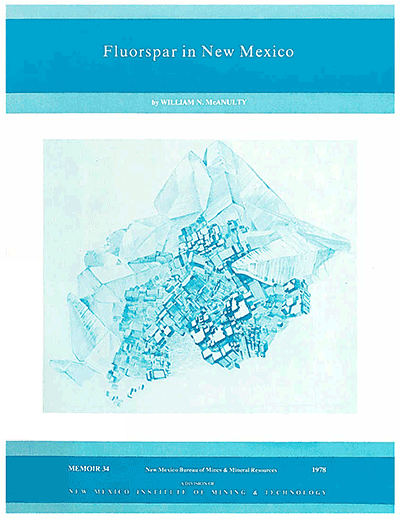
Memoir 34—Fluorspar in New Mexico
By W. N. McAnulty, 1978, 64 pp., 6 tables, 42 figs., 14 sheets in pocket, 1 index.

Describes geology, mining, and uses of fluorspar; lists deposits and discusses major occurrences. Current knowledge and theories about the geology of fluorspar are summarized, and the many industrial uses of this important mineral commodity are discussed in this report. New geological data on several fluorspar districts and specific deposits in New Mexico, and the results of recent detailed studies of several areas by graduate students at University of Texas at El Paso and University of Western Ontario, and by the writer, are also presented. Exploration, new fluorspar discoveries, and mining performed in New Mexico since 1966 are included. The tonnage and grade of identified reserves in the United States are inadequate to supply the domestic demand, and more than 80% of the fluorspar consumed in the United States is imported. Southwestern New Mexico is a fluorine-rich province in which more than 200 fluorspar deposits have been discovered in districts scattered over 13 counties. Systematic exploration in several districts could discover large low-grade resources, particularly fluorspar-bearing jasperoid deposits. In the not too distant future, deposits in New Mexico may become significant sources of fluorspar.
Fluorspar is the commercial name for an aggregate of rock and mineral matter containing a sufficient amount of the mineral fluorite (CaF2) to qualify the aggregate as a marketable commodity, or as a primary source ore of a profitable, salable product after benefication. Fluorite is the principal source of fluorine, an element which is used in many ways by modern industry, and there are no adequate substitutes for it in any of its major uses. The principal uses of fluorspar are as a source of fluorine for making hydrofluoric acid (HF), as a flux in metallurgy, and as a raw material in the manufacture of glass and enamels. Fluorspar is a relatively scarce mineral commodity, and the United States imports more than 80% of its requirements. Although occurrences of fluorspar are known at more than 200 different places scattered over 13 counties in New Mexico, and small-scale mining has been done on 91 deposits in 11 counties in the state, the aggregate total mine production of fluorspar in New Mexico since the early 1880s is approximately 700,000 tons of all grades. However, several companies, groups, and individuals are actively exploring and evaluating fluorspar districts in the state at the present time, and chances are good that New Mexico will become an important fluorspar producer in the near future.
Fluorite (Ca F2) is the most abundant fluoride mineral. It crystallizes in the isometric system, usually in cubic form but also in octahedral and dodecahedral forms. The mineral possesses perfect octahedral cleavage, has a hardness of 4 on the Mohs scale, and its specific gravity ranges from 3.01-3.6 in various forms; pure crystalline fluorite has a specific gravity of 3.18. Colors of the mineral vary greatly; fluorite may be colorless, white, yellow, green, violet, purple, blue, pink, red, brown, light- to dark-gray, or black. Crystalline varieties have a vitreous luster and range from transparent to subtranslucent; a diagnostic optical property of fluorite is its low index of refraction (n= 1.4339). It is isotropic, has low dispersion, and some varieties will transmit ultraviolet light.
$10.50
Buy
Now
Also available as a free download.
Download
| File Name | Size | Last Modified |
|---|---|---|
| Memoir-34.pdf | 9.50 MB | 01/19/2021 09:45:04 AM |



